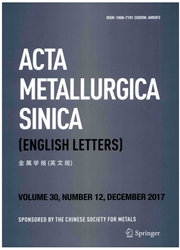

 中文摘要:
中文摘要:
Cu–Al/Al nanostructured metallic multilayers with Al layer thickness hAlvarying from 5 to 100 nm were prepared, and their mechanical properties and deformation behaviors were studied by nanoindentation testing. The results showed that the hardness increased drastically with decreasing hAldown to about 20 nm, whereafter the hardness reached a plateau that approaches the hardness of the alloyed Cu–Al monolithic thin films. The strain rate sensitivity(SRS, m),however, decreased monotonically with reducing hAl. The layer thickness-dependent strengthening mechanisms were discussed, and it was revealed that the alloyed Cu–Al nanolayers dominated at hAlB 20 nm, while the crystalline Al nanolayers dominated at hAl[ 20 nm. The plastic deformation was mainly related to the ductile Al nanolayers, which was responsible for the monotonic evolution of SRS with hAl. In addition, the hAl-dependent hardness and SRS were quantitatively modeled in light of the strengthening mechanisms at different length scales.
 英文摘要:
英文摘要:
Cu-Al/Al nanostructured metallic multilayers with Al layer thickness hAl varying from 5 to 100 nm were prepared, and their mechanical properties and deformation behaviors were studied by nanoindentation testing. The results showed that the hardness increased drastically with decreasing hAl down to about 20 nm, whereafter the hardness reached a plateau that approaches the hardness of the alloyed Cu-Al monolithic thin films. The strain rate sensitivity (SRS, m), however, decreased monotonically with reducing hAl. The layer thickness-dependent strengthening mechanisms were discussed, and it was revealed that the alloyed Cu-Al nanolayers dominated at hAl≤ 20 nm, while the crystalline Al nanolayers dominated at hAl 〉 20 nm. The plastic deformation was mainly related to the ductile Al nanolayers, which was responsible for the monotonic evolution of SRS with hAl. In addition, the hAFdependent hardness and SRS were quanti- tatively modeled in light of the strengthening mechanisms at different length scales.
 同期刊论文项目
同期刊论文项目
 同项目期刊论文
同项目期刊论文
 Emergence of external size effects in the bulk-scale polycrystal to small-scale single-crystal trans
Emergence of external size effects in the bulk-scale polycrystal to small-scale single-crystal trans Crystallization-aided extraordinary plastic deformation in nanolayered crystalline Cu/amorphous Cu-Z
Crystallization-aided extraordinary plastic deformation in nanolayered crystalline Cu/amorphous Cu-Z Strain rate sensitivity of nanolayered Cu/X (X=Cr, Zr) micropillars: Effects of heterophase interfac
Strain rate sensitivity of nanolayered Cu/X (X=Cr, Zr) micropillars: Effects of heterophase interfac Strain rate effects on the mechanical response in multi- and single-crystalline Cu micropillars: Gra
Strain rate effects on the mechanical response in multi- and single-crystalline Cu micropillars: Gra Comparisons between homogeneous boundaries and heterophase interfaces in plastic deformation: Nanost
Comparisons between homogeneous boundaries and heterophase interfaces in plastic deformation: Nanost 期刊信息
期刊信息
